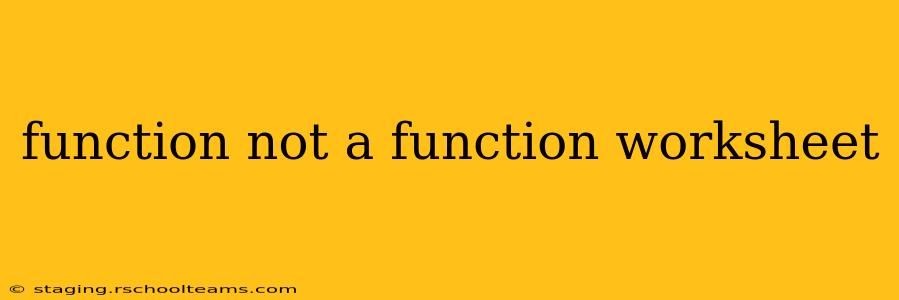Determining whether a relation is a function is a fundamental concept in algebra. This worksheet will guide you through identifying functions and non-functions using various representations, building a strong understanding of this crucial mathematical concept.
What is a Function?
A function is a relation where each input (x-value) has only one output (y-value). Think of it like a machine: you put in an input, and it gives you exactly one output. If you put in the same input twice, you must get the same output. If you get multiple outputs for a single input, it's not a function.
Identifying Functions: Different Representations
We can represent relations in several ways, and understanding how to identify functions in each representation is key.
1. Ordered Pairs
Example: {(1, 2), (2, 4), (3, 6), (4, 8)}
This is a function because each x-value (1, 2, 3, 4) is paired with only one y-value.
Example: {(1, 2), (1, 3), (2, 4)}
This is not a function because the x-value 1 is paired with two different y-values (2 and 3).
2. Tables
| x | y |
|---|---|
| 1 | 2 |
| 2 | 4 |
| 3 | 6 |
| 4 | 8 |
This table represents a function.
| x | y |
|---|---|
| 1 | 2 |
| 1 | 3 |
| 2 | 4 |
This table does not represent a function because x = 1 has two different y-values.
3. Graphs
The Vertical Line Test is crucial for identifying functions from graphs. If any vertical line intersects the graph more than once, it is not a function.
Example: A straight line (except a vertical line) will always represent a function.
Example: A circle or an ellipse does not represent a function because a vertical line can intersect it at two points.
4. Equations
Equations can also represent functions. To check if an equation represents a function, you can try solving for y. If you get more than one solution for y for a single x, then the equation does not represent a function.
Example: y = 2x + 1 (This is a function)
Example: x² + y² = 9 (This is not a function; solving for y yields two solutions: y = ±√(9 - x²))
Practice Problems
Now let's practice! Determine whether each of the following represents a function. Explain your reasoning.
-
{(2, 3), (4, 5), (6, 7), (8, 9)}
-
{(1, 1), (2, 2), (3, 3), (1, 4)}
-
x y 0 1 1 2 2 3 3 4 x y --- --- 1 2 1 3 2 4 -
A graph showing a parabola opening upwards.
-
A graph showing a sideways parabola (opening to the right).
-
y = x³
-
x = y²
Frequently Asked Questions (FAQs)
How can I quickly check if a graph is a function?
Use the vertical line test. Draw vertical lines across the graph. If any vertical line intersects the graph more than once, it's not a function.
Can a function have repeated y-values?
Yes, absolutely! A function can have multiple inputs mapping to the same output. What it cannot have is one input mapping to multiple outputs.
What's the difference between a relation and a function?
All functions are relations, but not all relations are functions. A relation is simply a set of ordered pairs. A function is a specific type of relation where each input has only one output.
This worksheet provides a solid foundation for understanding functions and non-functions. Mastering this concept is crucial for further studies in mathematics. Remember to practice regularly to reinforce your understanding!
